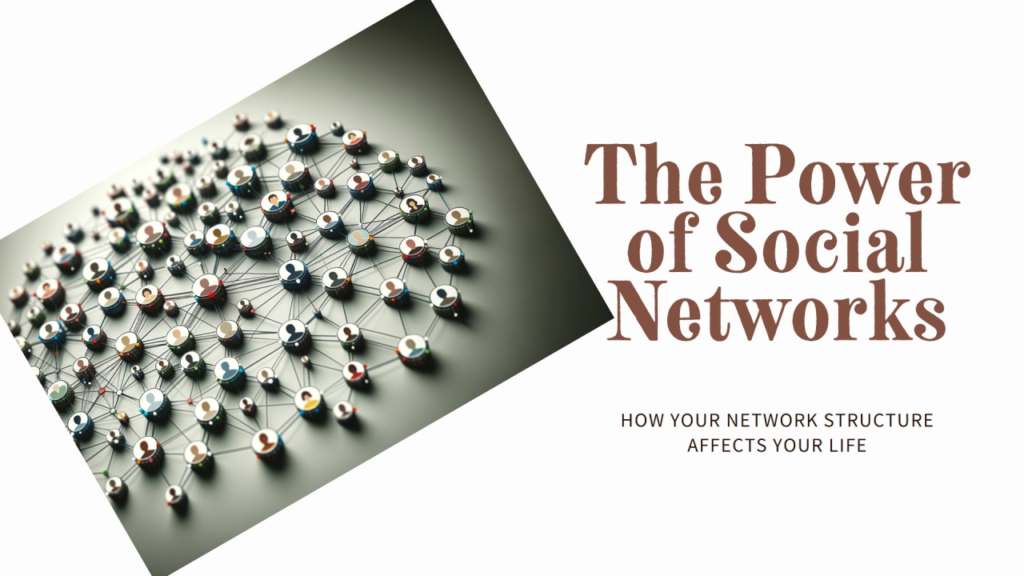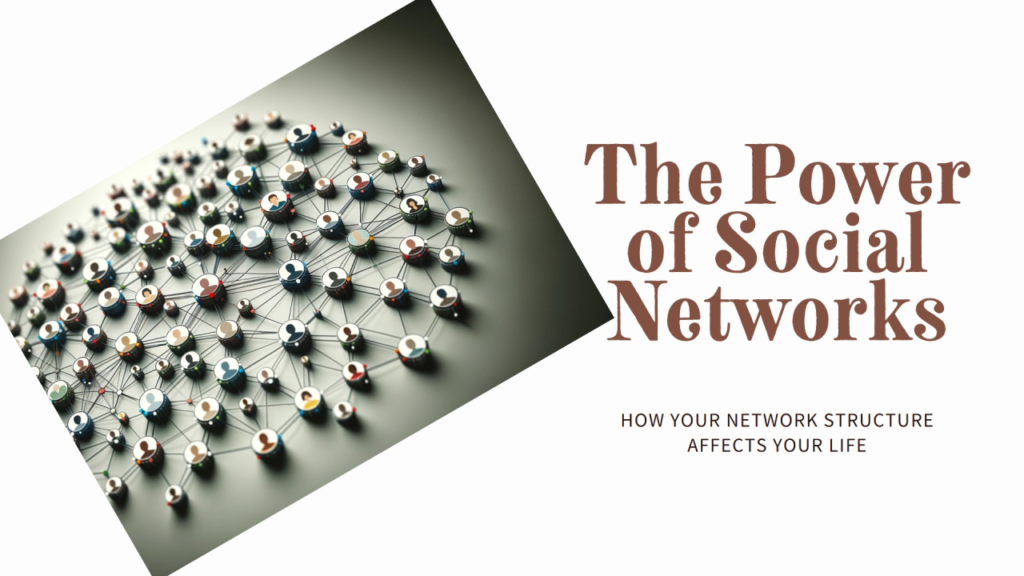Your Network Structure Matters: The Impact of Social Networks on Professional and Personal Outcomes

The structure of one’s social network—whether large and diverse or small and dense—can significantly influence the types of benefits one receives. Understanding and strategically managing these networks can lead to a variety of positive outcomes.
The Benefits of Large, Diverse Networks
Access to Novel Sources of Information: Large and diverse networks, rich in weak ties and “structural holes,” provide access to a wider array of information. Weak ties, or casual acquaintances, are often more likely to introduce novel ideas and opportunities than strong ties, which are typically more redundant in the information they offer. Structural holes, the gaps between non-redundant contacts, allow individuals to broker information and connect disparate groups, leading to innovative solutions and insights.
Fruitful Inventions and Career Advancement :Innovation thrives in environments where diverse ideas can cross-pollinate. A network rich in weak ties allows individuals to gather varied perspectives, leading to more creative and innovative outcomes. Additionally, these networks are instrumental in career advancement as they provide exposure to different industries and opportunities, often leading to unexpected career shifts and promotions.
Discovery of New Jobs Job opportunities often come from unexpected sources. Large, diverse networks increase the likelihood of learning about job openings that are not publicly advertised. Weak ties can be particularly valuable here, as they often connect individuals to new groups and opportunities beyond their immediate circles.
The Benefits of Small, Dense Networks
Increased Accessibility: In small, dense networks, individuals have strong ties characterized by frequent interactions and high levels of trust. These networks ensure that members are readily accessible to one another, facilitating quick and effective communication.
Help with Resource Mobilization: Strong ties in a close-knit network are crucial when mobilizing resources. Whether it’s gathering support for a project, securing funding, or rallying around a common cause, the trust and commitment within these networks make resource mobilization more efficient.
Protection in Times of Danger or Uncertainty :During times of crisis or uncertainty, strong networks provide a safety net. The deep trust and emotional support within these networks offer protection and assistance, ensuring that individuals are not left to face challenges alone.
Types of Networks in Professional Life
1. Work Network:
Comprises individuals with whom you exchange information as part of your daily work routines.
2. Social Network:
Includes those you check in with both inside and outside the office to stay updated on what’s happening.
3. Innovation Network:
Consists of colleagues with whom you collaborate and brainstorm new ideas.
4. Expert Knowledge Network:
Made up of individuals you turn to for expertise or advice about the enterprise.
5. Career Guidance or Strategic Network:
Encompasses mentors and advisors who provide guidance about your future.
6. Learning Network : Involves those you work with to improve existing processes or methods.
Building and Maintaining Effective Networks:
Know Your Business and Organization: Understand the direction your group or organization is heading. This knowledge helps in aligning your network building efforts with organizational goals.
Map Your Web: Visualize your network to identify key connections and gaps. This mapping can reveal areas where you need to strengthen relationships or build new ones.
Create Your Network: Actively seek to build a diverse and balanced network. Engage with individuals across different functions and levels within and outside your organization.
Sustain Your Network: Regularly nurture your connections. Keeping in touch, offering help, and staying engaged are crucial for maintaining a vibrant and effective network.
Evaluating Your Network Connections When assessing the value of your network connections, consider the following questions:
Information Value: How valuable is the information I receive from this person?
Collaboration: How well does this person collaborate with me to solve problems and make decisions?
Awareness of Skills: How aware is this person of my skills?
Accessibility: How accessible is this person to me?
Engagement: How “engaged” is this person with me?
Safety in Communication: How safe is it to communicate with this person?
Quality of Conversation: What is the level of quality of conversation with this person?
Productivity: To what degree is my productivity improved by this person?
Power and Influence: How much power and influence does this person have?
Personal Affinity: How much do I like this person?
Career Support: To what degree does this person support the achievement of my career goals?
Personal Goals: To what degree does this person support the achievement of my personal goals?
Energy Impact: To what degree does this person energize (or exhaust) me?
Trust: To what degree do I trust this person?
Social Network Analysis (SNA)
Social Network Analysis (SNA) is a methodological approach to studying social networks. It involves mapping and measuring relationships and flows between people, groups, organizations, computers, or other connected entities. SNA provides both visual and mathematical analysis of human relationships.
How to Conduct Social Network Analysis
1. Data Collection: Gather data on relationships and interactions within the network. This can be done through surveys, interviews, digital communication records, or observation.
2. Data Preparation: Organize the data into a structured format, often as a matrix where rows and columns represent network participants, and the cells represent the presence or strength of a relationship.
3. Network Visualization: Use software tools like Gephi, UCINET, or NodeXL to create visual representations of the network. Nodes represent individuals or entities, and edges represent the relationships between them.
4. Analysis: Analyse the network using various metrics:
– Degree Centrality: Measures the number of direct connections an entity has.
– Betweenness Centrality: Assesses the extent to which an entity lies on the shortest path between other entities.
– Closeness Centrality: Evaluates how close an entity is to all other entities in the network.
– Eigenvector Centrality: Measures the influence of an entity in the network, considering the influence of its connections.
5. Interpretation: Interpret the results to understand the network’s structure, identify key influencers, and detect subgroups or clusters within the network.
Benefits of Social Network Analysis
– Enhanced Communication: Identifies bottlenecks and isolated individuals, helping improve communication flows.
– Improved Collaboration: Reveals collaboration patterns and highlights areas where connections can be strengthened.
– Innovation Boost: Uncovers opportunities for innovative collaborations by identifying disconnected groups or individuals.
– Resource Optimization: Helps in efficiently allocating resources by understanding the network’s structure and dynamics.
– Risk Management: Detects vulnerabilities in the network, enabling better risk management and contingency planning.
Example of an SNA Visualization:
Imagine a simple network graph for a small team within an organization:
– Nodes: Alice, Bob, Carol, Dave, and Eve.
– Edges: – Alice is connected to Bob, Carol, and Eve. – Bob is connected to Alice and Dave. – Carol is connected to Alice and Dave. – Dave is connected to Bob and Carol. – Eve is connected to Alice. In this visualization: – Alice might appear larger if she has the most connections (degree centrality). – If Alice connects otherwise disconnected nodes (structural holes), she might be highlighted for her betweenness centrality. – Communities might be color-coded to show that Alice, Bob, and Carol form one cluster, while Dave and Eve form another if they have stronger internal connections. While I can’t provide a direct visual here, there are several tools available to create such visualizations, like Gephi, UCINET, and NodeXL. These tools allow users to input data and generate network graphs with various analytical highlights. If you input the above relationships into one of these tools, you could generate a visual network similar to the described example.
In Social Network Analysis (SNA), centrality metrics are used to identify the most important nodes within a network.
Here are some common centrality metrics used in SNA:
1. Degree Centrality: – Measures the number of direct connections a node has. Nodes with high degree centrality are considered important in terms of network connectivity.
2. Betweenness Centrality: – Measures the extent to which a node lies on the shortest paths between other nodes in the network. Nodes with high betweenness centrality act as bridges between different parts of the network.
3. Closeness Centrality: – Measures how close a node is to all other nodes in the network. Nodes with high closeness centrality can quickly interact with other nodes in the network.
4. Eigenvector Centrality: – Considers both the number and the quality of a node’s connections. Nodes connected to other well-connected nodes have higher eigenvector centrality.
5. PageRank: – Originally developed by Google, PageRank measures the importance of a node based on the number and quality of links pointing to it. Nodes with high PageRank are considered influential.
6. Katz Centrality: – Similar to eigenvector centrality but also considers indirect connections. It assigns higher centrality to nodes that are connected to other highly central nodes.
7. Harmonic Centrality: – Measures the average reciprocal distance from a node to all other nodes in the network. Nodes with high harmonic centrality are close to many other nodes. These centrality metrics help in understanding the structural importance of nodes within a network and can provide insights into key players, information flow, and network dynamics. Different metrics may be more suitable depending on the specific research question or context of the network being analysed.
Network density is a crucial concept in Social Network Analysis (SNA) as it provides insights into the overall structure and connectivity of a network. The significance of network density in SNA includes:
1. Overall Connectivity: Network density measures the proportion of connections that exist in a network relative to the total possible connections. A high network density indicates a network where many relationships exist among nodes, leading to a more interconnected structure.
2. Information Flow: In a dense network, information, resources, or influence can flow more easily between nodes due to the numerous connections. This can impact how quickly and efficiently information spreads within the network.
3. Resilience and Robustness: Networks with higher density tend to be more resilient to node failures or disruptions. The redundancy of connections in a dense network can help maintain connectivity even if some nodes are removed.
4. Community Detection: Network density can influence the identification of communities or clusters within a network. Dense areas of connections may indicate cohesive groups or subgroups of nodes that interact more frequently with each other.
5. Centralization: The density of a network can also affect the distribution of centrality within the network. In denser networks, centrality metrics like degree centrality or betweenness centrality may be more evenly distributed among nodes compared to sparse networks.
6. Network Evolution: Changes in network density over time can indicate shifts in relationships, collaborations, or interactions within a network. Monitoring changes in density can help in understanding network dynamics and evolution.
7. Resource Allocation: Understanding network density can inform decisions related to resource allocation, communication strategies, or identifying key nodes for interventions or information dissemination. Overall, network density provides a quantitative measure of how tightly interconnected nodes are within a network, offering valuable insights into the structure, dynamics, and functioning of social networks in various contexts.
Understanding and strategically managing your social networks is crucial for accessing information, advancing your career, and achieving personal and professional goals. Whether through large, diverse networks that introduce novel ideas or small, dense networks that provide robust support, the structure of your social connections profoundly impacts your success and well-being. By actively building and maintaining these networks and utilizing tools like Social Network Analysis, you can leverage their full potential to navigate your professional landscape effectively.






Responses